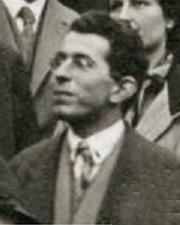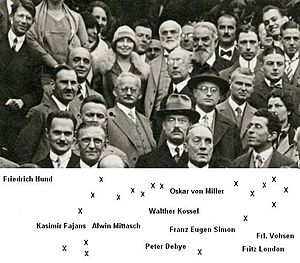Fritz London facts for kids
Quick facts for kids
Fritz London
|
|
|---|---|

Fritz London (1928)
|
|
| Born |
Fritz Wolfgang London
March 7, 1900 Breslau, Silesia, Germany
|
| Died | March 30, 1954 (aged 54) |
| Nationality | German |
| Citizenship | German, later US |
| Known for | Quantum chemistry London dispersion forces London equations London moment London penetration depth |
| Awards | Lorentz Medal (1953) |
| Scientific career | |
| Fields | Theoretical physics |
| Institutions | Duke University University of Berlin University of Oxford Collège de France |
| Academic advisors | Max von Laue |
Fritz Wolfgang London (March 7, 1900 – March 30, 1954) was an important German-born physicist. He later became a professor at Duke University in the United States.
He made big discoveries about how atoms stick together to form molecules (called chemical bonding). He also studied the tiny forces between molecules, known as London dispersion forces. These ideas are now taught in science textbooks everywhere.
With his brother Heinz London, Fritz London helped us understand how superconductors work. Superconductors are special materials that can carry electricity without any loss. Their work led to the famous London equations. Fritz London was even nominated for the Nobel Prize in Chemistry five times!
Contents
Biography
Fritz London was born in Breslau, Germany (which is now Wrocław, Poland) in 1900. His father was Franz London.
Because he was Jewish, Fritz London lost his job at the University of Berlin. This happened after Hitler's Nazi Party passed unfair laws in 1933. These laws were designed to remove Jewish people from their jobs.
After losing his job, London took temporary positions in England and France. He moved to the United States in 1939 and became an American citizen in 1945. Later in his life, he was a professor at Duke University.
In 1953, he received the Lorentz Medal for his scientific achievements. Fritz London passed away in Durham, North Carolina, in 1954, due to a heart problem.
Amazing Discoveries in Physics
London's early work with another scientist named Walter Heitler was about how atoms form chemical bonds. This was a huge step forward in understanding how molecules like H2 (two hydrogen atoms) are held together.
Their work came out shortly after Heisenberg and Schrödinger introduced quantum mechanics. Quantum mechanics was key to explaining how atoms share electrons to form a covalent bond. They also realized that electrons are "indistinguishable," which is part of the Pauli principle.
Understanding Intermolecular Forces
London also did important work on intermolecular forces. These are the tiny forces that pull molecules together or push them apart. He came up with the term "dispersion effect" to describe the attraction between two noble gas atoms. Today, this attraction is often called the "London force."
In 1930, he worked with R. Eisenschitz to explain how two noble gas atoms interact. They showed that these atoms attract each other when they are far apart. But they push each other away when they get very close. This repulsion happens because of the Pauli principle, which says that electrons must behave in a certain way.
For atoms and molecules that don't have a positive or negative end (called nonpolar molecules), the London dispersion force is the only intermolecular force. It's what allows these substances to exist as liquids and solids. For polar molecules (which have positive and negative ends), this force is part of the larger van der Waals force.
Superfluidity and Quantum Mechanics
Fritz London was the first to suggest a groundbreaking idea about superfluidity. Superfluidity is a strange state where a liquid can flow without any friction. London believed it was connected to something called Bose–Einstein condensation. This is a phenomenon where many particles (called bosons) act like one big wave.
He also helped scientists understand the principle of "local gauge invariance" in quantum mechanics. This is a complex idea about how the laws of physics stay the same even when certain measurements change.
London also predicted that superconductors would have "flux quantization." This means that magnetic fields inside a superconductor can only exist in specific, tiny amounts. With his brother Heinz, he proposed that superconductors push out magnetic fields. This happens over a very short distance, which is now called the London penetration depth.
He also developed a theory about how superconductors react when they spin. He showed that a spinning superconductor creates its own magnetic field, known as the London moment. This effect is even used in models to understand how neutron stars spin!
Fritz London Memorial Lectures and Prize
Since 1956, the Fritz London Memorial Lectures have brought many famous scientists to Duke University. These lecturers include Nobel Prize winners. They talk about topics related to the fields of physics and chemistry that Fritz London studied.
In 1972, John Bardeen, who won the Nobel Prize in Physics twice, set up a special fund. This fund helps to remember Fritz London and support physics research at Duke University. The fund is used to give out the Fritz London Memorial Prize. This prize is awarded to people who make outstanding contributions to low-temperature physics. It also helps support the London Memorial Lectures.
See also
 In Spanish: Fritz London para niños
In Spanish: Fritz London para niños
Images for kids



